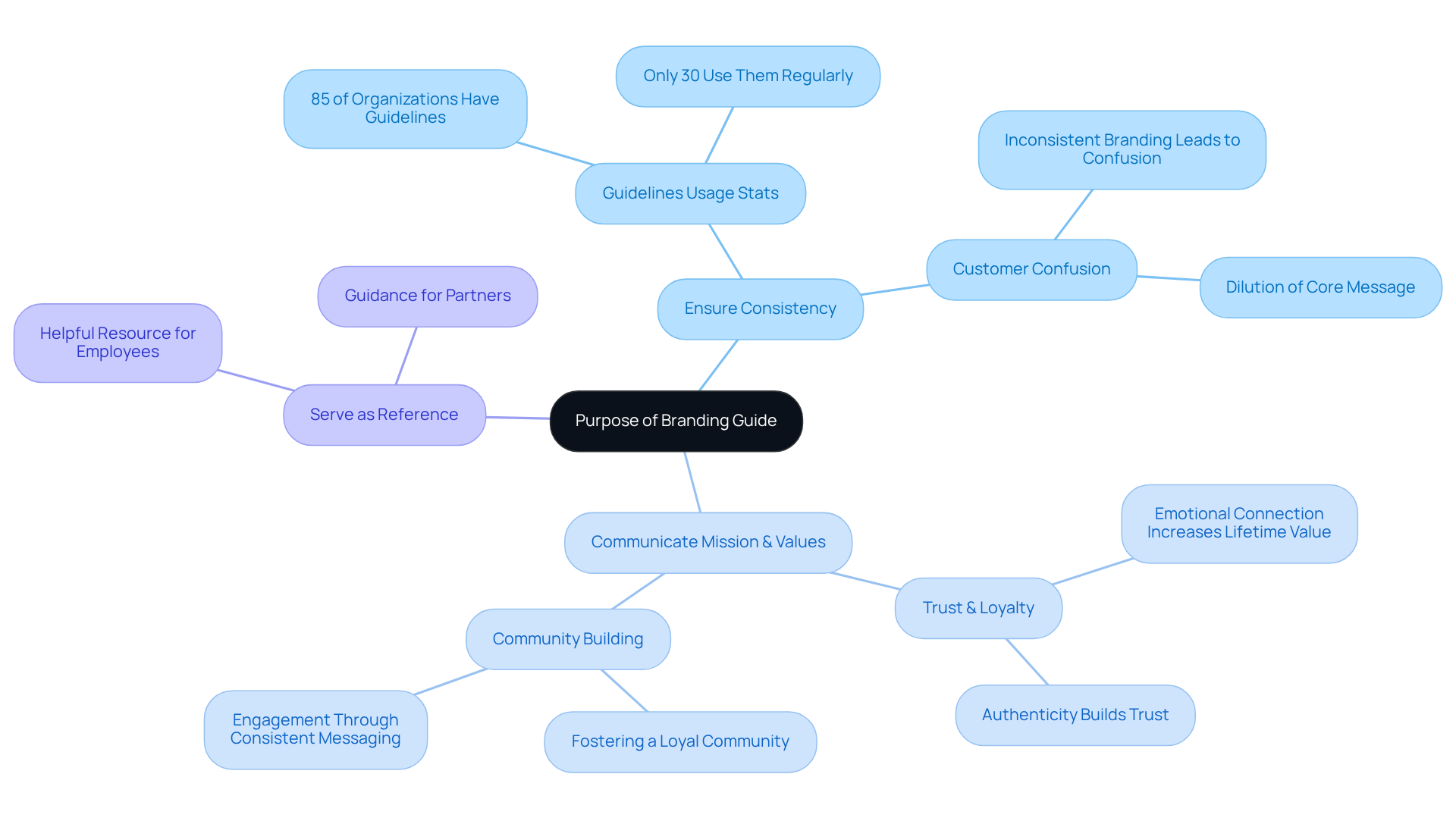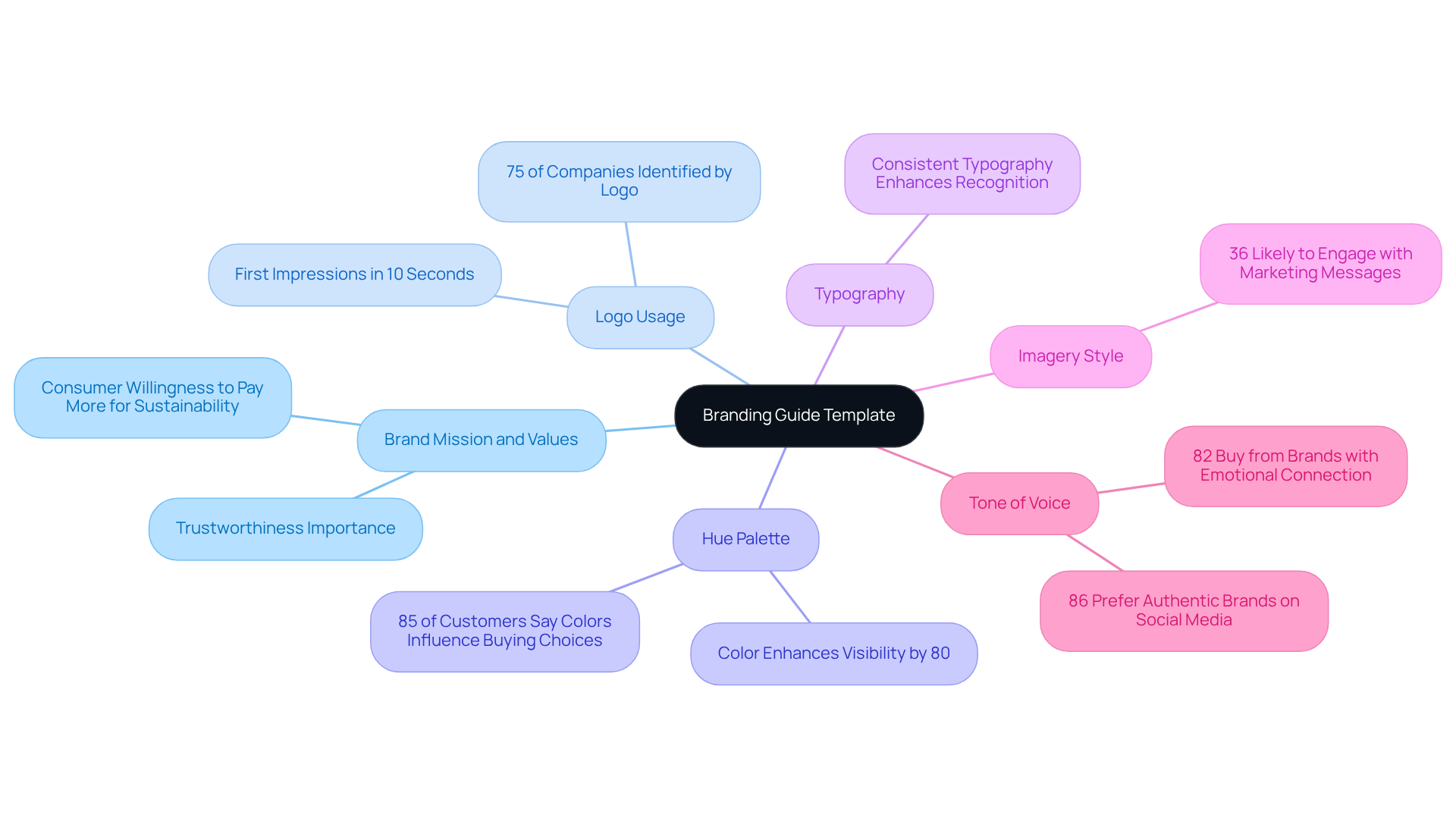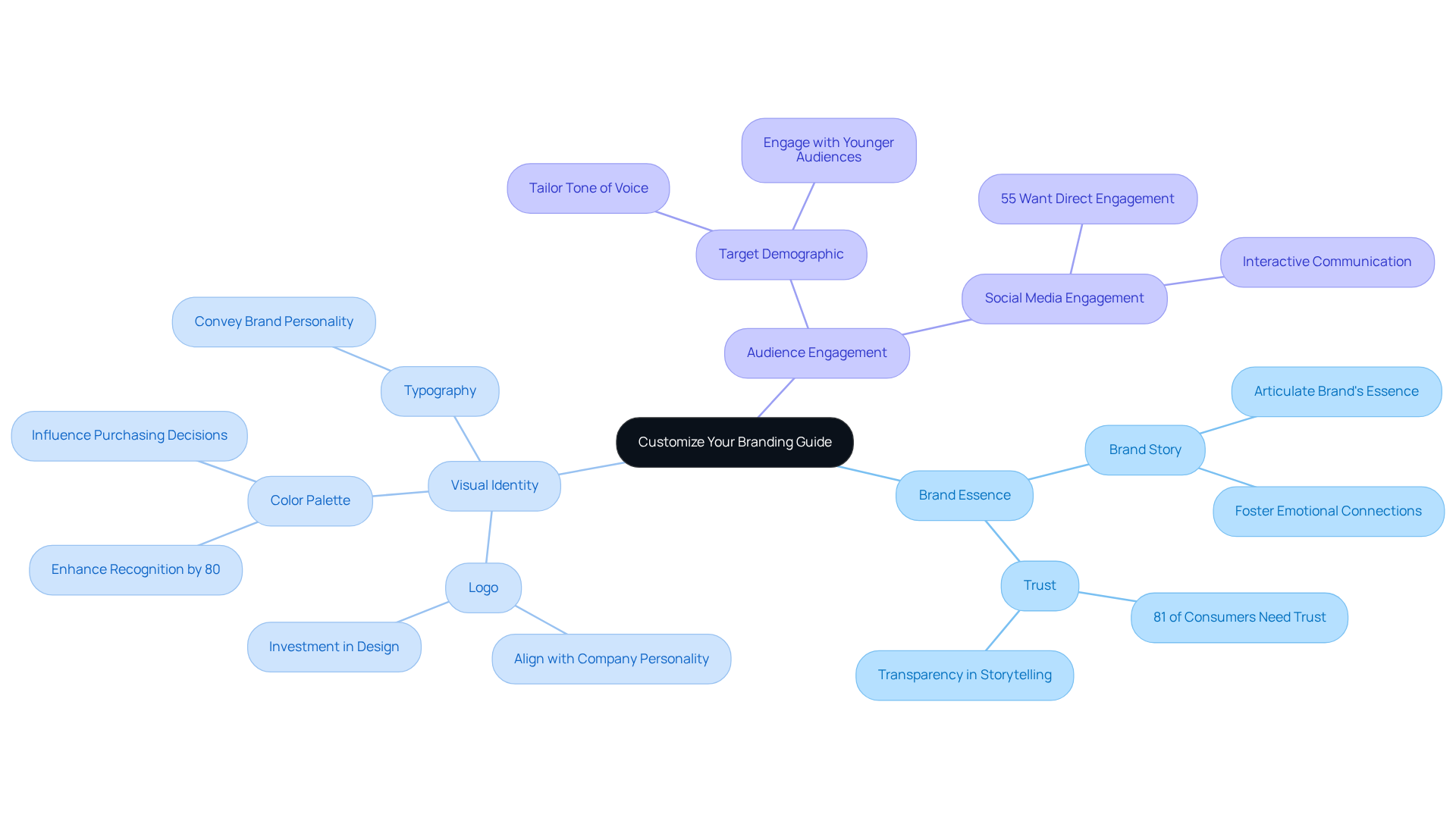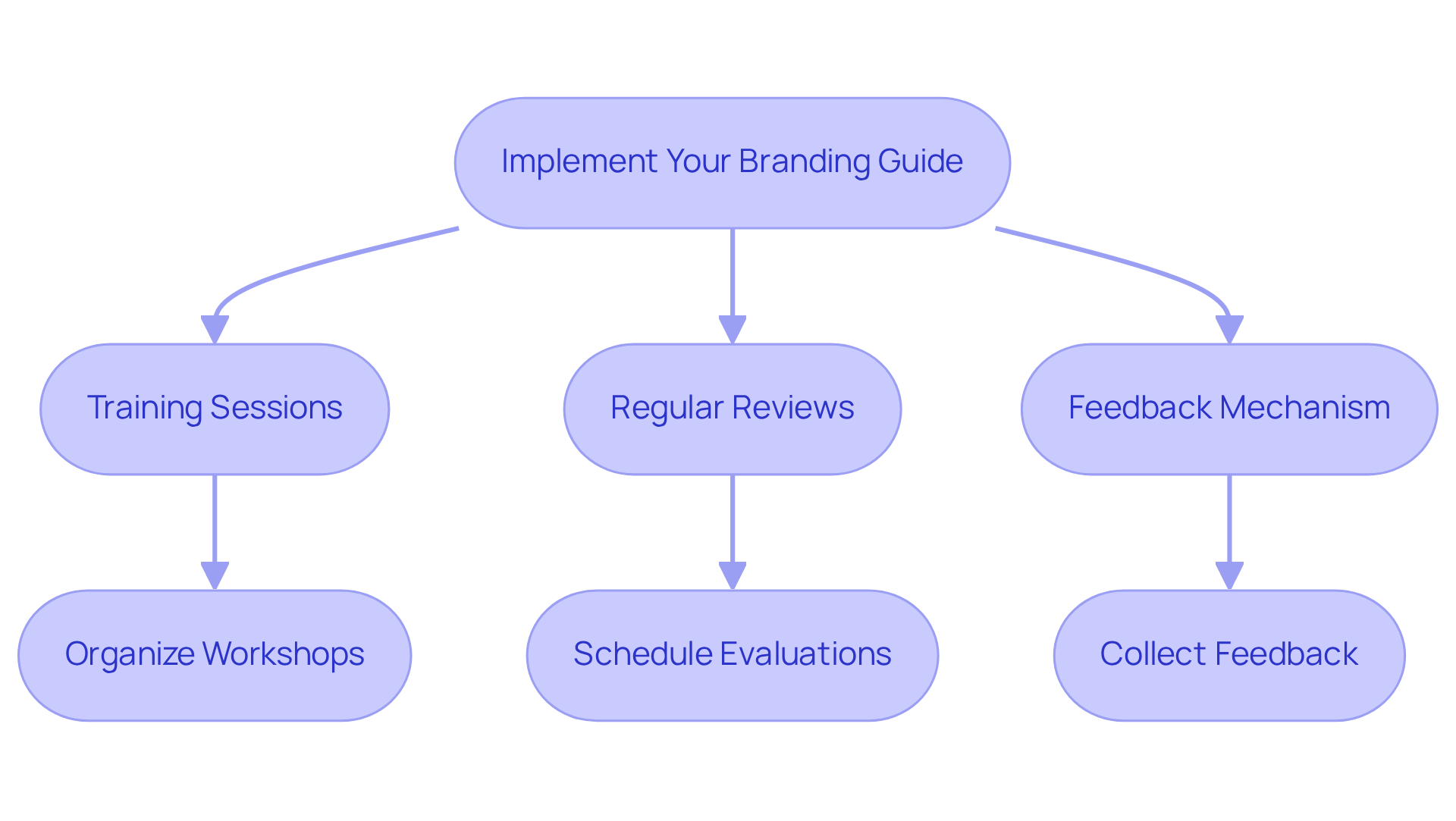Overview
Creating an effective branding guide template can feel overwhelming for many tech startup founders. You might find yourself wondering how to clearly define your brand's identity and purpose. This uncertainty can lead to miscommunication and missed opportunities for connection with your audience. It’s essential to address this challenge head-on by recognizing the key elements that make up a strong branding guide.
Start by defining the purpose of your guide. What do you want your brand to communicate? Identifying crucial elements like your mission, logo usage, and color palette is vital. These components are not just technical details; they are the heart of your brand’s story. Customizing the guide to reflect your unique identity will ensure it resonates with your audience, fostering a deeper connection.
Once your branding guide is established, it’s important to implement it consistently in your daily operations. This consistency is what builds brand loyalty and recognition over time. As you navigate the challenges of startup life, remember that a well-defined brand can serve as a guiding light, helping you stay true to your mission and values.
We understand that this journey can be daunting, but you’re not alone. By taking these essential steps, you can create a branding guide that not only supports your business objectives but also nurtures a community around your brand. Together, let’s embark on this journey to create a meaningful and impactful brand identity.
Introduction
Crafting a branding guide is not merely a creative task; it is a strategic necessity for any organization striving to build a strong and consistent identity in today’s bustling marketplace. This guide becomes a vital tool, ensuring that every piece of marketing material aligns with the brand's core values and mission. Yet, despite the widespread acknowledgment of its significance, many businesses find themselves grappling with the effective implementation of these guidelines. This struggle often leads to inconsistencies that can bewilder customers and erode brand loyalty.
How can organizations bridge this gap? How can they create a branding guide that not only mirrors their unique identity but also nurtures lasting connections with their audience? Together, we can explore solutions that foster understanding and support your journey toward a cohesive brand presence.
Define the Purpose of Your Branding Guide
To begin crafting your branding guide template, it's essential to outline its purpose. Reflect on what you hope to achieve with this resource. Many organizations aim to ensure consistency across various platforms, communicate their mission and values, and provide a helpful reference for employees and partners. Consider writing a concise statement that captures this purpose, guiding the development of the rest of your guide. For example, your goal might be: To offer a comprehensive resource that guarantees all [marketing materials represent our identity](https://blog.rno1.com/10-business-mission-statement-samples-for-tech-startups) and values consistently.
However, it’s important to recognize a significant challenge: statistics reveal that while 85% of organizations have guidelines to enhance consistency, only 30% utilize them regularly. This inconsistency can lead to confusion for customers and dilute your core message. As Huddle Creative wisely notes, "When your identity is consistent and authentic, it helps foster a loyal community that connects with what you represent." Take inspiration from successful examples like the Houston Rockets, who demonstrate how a dedicated color palette and design elements can reinforce identity. Additionally, consider that customers typically need to encounter a label at least seven times before deciding to purchase, highlighting the crucial role of consistent marketing initiatives.
By establishing a solid objective for your branding guide template, you not only nurture trust and loyalty among consumers but also position your brand for long-term success in a competitive landscape. Remember, you are not alone in this journey; many founders share similar experiences and challenges. Together, we can create a that resonates deeply with your audience and fosters a community around your brand.

Identify Key Elements to Include in Your Template
Next, let’s explore the essential elements that should be part of your branding guide template. Understanding these components can be a game-changer for your and connection with consumers.
- Brand Mission and Values: It’s vital to clearly articulate what your brand stands for. A powerful mission statement not only outlines your objectives but also builds consumer trust. In fact, 31% of consumers view trustworthiness as the most essential element of a company. Moreover, 73% of consumers are willing to spend more on products from eco-friendly companies, highlighting the importance of aligning your mission with their values. At RNO1, we truly believe that a design-focused mission can significantly enhance your product's marketability and resonate deeply with your audience.
- Logo Usage: Providing guidelines on how to use your logo, including variations, spacing, and exclusion zones, is crucial. Remember, it takes just 10 seconds for people to form an opinion about a logo, making consistency essential. Additionally, 75% of companies are identified by their logo, underscoring the necessity for clear usage guidelines. Our design-focused approach ensures that your logo stands out while effectively conveying the essence of your identity.
- Hue Palette: Defining primary and secondary shades, along with HEX codes, is another key aspect. Color significantly influences product recognition, with research indicating that consistent hue usage can enhance visibility by up to 80%. Furthermore, 85% of customers assert that hues enhance visibility and influence their buying choices, emphasizing the importance of a clearly defined palette. At RNO1, we prioritize the strategic use of color to amplify design impact and shape company perception.
- Typography: It’s important to specify fonts for headings, body text, and any other text elements. Typography plays a crucial role in visual identity, and consistent use across media enhances recognition of your organization. Our design philosophy embraces typography that not only looks appealing but also resonates with your company's voice.
- Imagery Style: Outlining the types of images that reflect your identity is essential. Incorporating image style guidelines guarantees a uniform photographic or illustrative style, which is vital for maintaining identity. Notably, 36% of consumers are likely to engage with companies through marketing messages, highlighting the significance of imagery in fostering engagement. RNO1's design-centric approach ensures that your imagery resonates with your audience and enhances their interaction with your brand.
- Tone of Voice: Describing the language style and tone for your communications is crucial. A clearly defined tone of voice helps in establishing emotional connections with consumers, as 82% of customers are more inclined to purchase from companies they feel a strong emotional bond with. Additionally, 86% of consumers favor labels that exhibit an authentic and honest personality on social media. At RNO1, we advocate for a tone that embodies your design philosophy, ensuring that your communication style resonates with your audience and deepens emotional engagement.
By outlining these components, you lay the groundwork for your branding guide template, ensuring a comprehensive approach to your identity. This organized framework not only aids in preserving consistency but also enhances overall identity recognition and loyalty, reflecting RNO1's commitment to design-focused solutions.

Customize Your Branding Guide for Unique Identity
To effectively customize your branding guide template and reflect your unique identity, it's essential to address some common challenges you might face. Many startup founders struggle with articulating their brand's essence, which can lead to a disconnect with their audience. This disconnect not only affects engagement but can also hinder growth. In fact, studies show that 81% of consumers believe trust is crucial before making a purchase. By sharing your brand story, detailing its origins and evolution, you can foster those emotional connections that are so vital. Clarity and genuineness in your narrative can enhance this trust even further, as 77% of marketers affirm that effective marketing is key to long-term success.
Next, consider your visual identity. Aligning your logo, color palette, and typography with your company's personality is fundamental. For instance, tech startups often choose sleek, modern designs to convey innovation and forward-thinking. Research indicates that color can enhance recognition of a company by up to 80%, and 85% of consumers assert that colors boost visibility and influence purchasing choices. Choosing shades that resonate with your audience is not just a design choice; it's a way to connect on a deeper level.
Lastly, think about your audience. Tailoring the tone of voice and imagery to appeal to your target demographic is crucial. A youthful brand might adopt casual language and vibrant visuals, while a more established entity may prefer a sophisticated tone. Engaging directly with your audience is vital; 55% of consumers want companies to connect with them on social media. This highlights the .
By customizing these components, you create a branding guide template that acts as both a resource and a representation of your brand's core. This approach not only enhances customer loyalty but also fosters meaningful engagement, ultimately supporting your journey as a tech startup founder.

Implement Your Branding Guide in Daily Operations
To effectively implement your in daily operations, it’s essential to recognize the challenges you may face. Inconsistent branding can lead to confusion and disengagement among your audience, making it crucial to address this issue with empathy and care. Here are some actionable strategies that can help you foster a strong brand identity:
- Training Sessions: Consider organizing workshops that not only educate employees about the branding guide but also emphasize its importance. Engaging training sessions can significantly enhance adherence, as organizations with robust training programs often see a notable increase in employee retention. It’s worth noting that 88% of companies acknowledge that providing learning opportunities is vital for retaining talent, and 91% of L&D specialists view continuous learning as essential for workers’ career growth.
- Regular Reviews: Schedule periodic evaluations of your marketing materials to ensure they align with your identity guidelines. Consistent reviews are key to maintaining brand integrity, and studies show that companies prioritizing brand consistency can experience a 10-20% growth increase.
- Feedback Mechanism: Establish a system to collect feedback on the effectiveness of your promotional manual. This ongoing dialogue allows for continuous improvement, ensuring the resource remains relevant and impactful. Remember, 70% of employees are somewhat likely to seek new opportunities with organizations that invest in their development, which underscores the importance of listening to their voices.
Make it a priority to incorporate the branding guide template into the onboarding process for new employees. This approach not only familiarizes them with your brand from the start but also positions the guide as a go-to reference for all marketing and communication efforts, fostering a culture of awareness.
By actively implementing these strategies, you can ensure that your brand identity remains consistent and resonates with your audience across all platforms. This nurturing approach ultimately drives engagement and loyalty, creating a supportive environment for your team and customers alike.

Conclusion
Creating a comprehensive branding guide template is not just a task; it’s a vital step in nurturing a cohesive and recognizable brand identity. Many organizations struggle with maintaining consistent messaging that aligns with their core values, leading to confusion and a lack of trust among consumers. This inconsistency can diminish brand perception in a competitive landscape, which is a challenge that resonates deeply with many startup founders.
Key elements such as brand mission and values, logo usage, color palette, typography, imagery style, and tone of voice are essential to include in the guide. Each of these components significantly shapes how your brand is perceived and how effectively it connects with your audience. Customizing the branding guide to reflect a unique identity not only addresses the challenges faced by startups but also fosters deeper emotional connections with consumers, making them feel valued and understood.
Ultimately, the successful implementation of a branding guide in daily operations is crucial for maintaining brand integrity and fostering engagement. By prioritizing training, regular reviews, and feedback mechanisms, you can cultivate a culture of brand awareness and consistency within your organization. Embracing these practices strengthens customer loyalty and positions your brand for sustainable growth and success. Investing in a well-structured branding guide is not merely a strategic choice; it is a heartfelt commitment to building a brand that resonates deeply with your audience and stands the test of time. Remember, you are not alone in this journey; together, we can create a brand that truly reflects your vision and values.
Frequently Asked Questions
What is the purpose of a branding guide?
The purpose of a branding guide is to ensure consistency across various platforms, communicate an organization's mission and values, and provide a helpful reference for employees and partners.
Why is it important to have a branding guide?
A branding guide is important because it helps maintain a consistent identity, which fosters customer loyalty and prevents confusion. Inconsistent branding can dilute a brand's core message.
What statistics highlight the challenges of using branding guidelines?
Statistics show that while 85% of organizations have branding guidelines to enhance consistency, only 30% utilize them regularly, leading to potential confusion for customers.
How can a branding guide impact customer purchasing decisions?
Customers typically need to encounter a label at least seven times before deciding to purchase, emphasizing the importance of consistent marketing initiatives facilitated by a branding guide.
Can you provide an example of effective branding?
An example of effective branding is the Houston Rockets, who use a dedicated color palette and design elements to reinforce their identity.
What is a key takeaway for creating a branding guide?
Establishing a solid objective for your branding guide helps nurture trust and loyalty among consumers and positions your brand for long-term success in a competitive landscape.




